
How To Make A Hidden Treasure Book
World Book Day may have fallen earlier this month, but when you have a four year old child who devours reading books at the rate of knots then every day is a book day! Seeing my son settle himself down to read a book independently is one of the most amazing things I've seen as a mum, and it is reassuring to know that he already has a love of books.
Every child has at least one favourite story, and this easy craft activity can be used to help explore the book and bring the story to life.
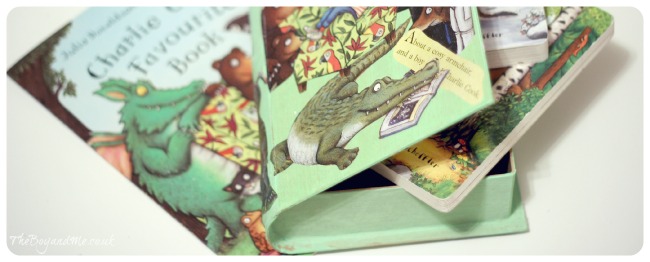
The Holiday Book Selector (Sponsored Post)
How do you select your reading material for holidays?
The idea of reading a themed book to suit the location of a holiday had never occurred to me until we were waiting in Heathrow for out flight to Italy about seven years ago. I was browsing the book stand in one of the many shops, and came across the book 'I Love Capri' by Belinda Jones. I'd never read any of her books before but as our destination was the Amalfi coast and a day trip to Capri then it seemed an apt book for a bit of holiday reading. It wasn't until we returned that I had the chance to finish the book, and in actual fact we planned another trip out there the following year visiting many of the places that the main character visited. It felt more real somehow; the holistic immersion into the culture of the people and the places we were visiting really made me appreciate where we were so much more. [Read more…]
10 Tips To Help Your Child When Reading A Book Together
It seems like listening to your child read a book should be simple: sit down together, and work through the text from the first page to the last.
And in practise that is exactly what we've been doing with The Boy for months. Which is ridiculous because I'd never ask one of the children I teach in school to cold-read a book, and they're over seven years old. So why on Earth have I not been drawing on my professional knowledge with my own child? My son, who is only four years old and just embarking on to the voyage of discovery that is accessible through learning to read.
If I was one of parents in my school, I'd be criticising myself in the staffroom. [Read more…]
Tidy Books Book Box (Review & Giveaway)
Books are an essential aspect of our home, and as I was sorting out The Boy's books after Christmas time I realised that he has very distinctly moved into a new phase of story books. Hardback books are long gone, the amount of text on a page has increased and the font is smaller, and the subject matter is more detailed.
We've also had to find space on his book shelves for his own reading books, those which I've bought him to practise and develop his reading skills. I have in the past tried to keep his books constrained to just the dining room, but when I was sent a new book box to review, it was the perfect excuse to gather all of his reading books together in one place and bring them into the living room.
With an advertised space for up to 40 books and four sections of two different heights, it's the perfect size to sit in the corner of our living room and appeal to The Boy to sit down and flick through a book and have a go at reading it by himself. In reality we actually have a lot more books in the book caddy than that, with over 120 small reading scheme style books in there, we've definitely got something to suit The Boy's moods and improving reading ability.
I set the book caddy up for The Boy one afternoon to explore after school and he found it really enticing. The fact that the books are forward facing is incredibly useful, because actually children do judge a book by its cover, especially if they can't read the title!
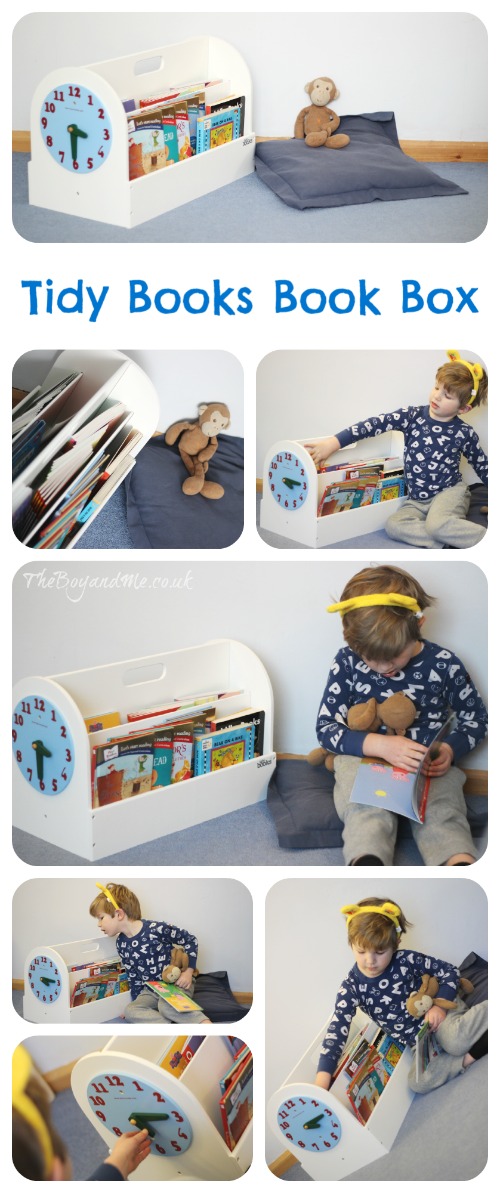
The Tidy Books' book box measures 34 cm (h) x 54 cm (w) x 28cm (d) and had a lovely play clock which can be attached at one end (although it can also be removed when children are older) with moving hands for The Boy to practise reading the time on. Assembly was simple, the book box arrives flat-packed in a carry box, and it took me less than five minutes to put it together with the provided alan key. Made from sustainable wood, not MDF, the book box is also finished in a water-based lacquer which is a safe, virtually odour free lacquer which is better for the environment and is ideal for children and allergy sufferers.
I find it very reassuring that the product has been made in a very responsible manner with sustainable resources and harmless paints. The finish and quality of the product is amazing, there are no sharp edges or splinters of wood on the screw holes, and it's the type of book box which will be used for longer than a few years; I can see it being passed down through the family.
The Tidy Books Book Box is available in a dark petrol blue, white or natural finish, and is priced at £69.00. While that may seem a little more expensive than some cheap high-street alternatives, the comparative quality is indisputable and this is one of those cases where it's worth spending a little more for something that will last years.
However, I am very fortunate to be able to offer a Tidy Books Book Box to one lucky reader of TheBoyandMe. Simply fill in the Rafflecopter form below for the chance to win one.
I was sent this product for the purpose of this review, my opinion is honest and unbiased.
What's The Point Of A Bedtime Book?
For the past four years, since The Boy was six months old, we've had the same bedtime routine every night; no electronic devices or television from 5.30p.m. onwards, dinner, play a calming game, upstairs for a bath (every alternate night), pyjamas, first book, brush teeth, kisses and cuddles good night from the adult not doing bedtime, second book, lights out.
I feel very strongly that children's minds need to 'wind down' at the end of the day to enable them to sleep peacefully, and for me that means no stimulation from a television or a mobile device. Setting a peaceful tone and giving children the opportunity to make sense of their days and the world in which they live.
As a baby, the consistency of our bedtime routine sent The Boy silent signals about what the time of day was and what was going to happen. As a school-aged child the routine is just as important, but for very different reasons.
Reading good quality fiction is an essential tool for many reasons; not only is it a bonding experience between the child and the adult, but it also helps develop the child's imagination and their vocabulary. The Boy is an early stage reader who is progressing really well with the amount of words that he is beginning to recognise by sight. Children learn through modelling and exploration; seeing an adult decode words, using expression and fluency, recognising punctuation and using it appropriately, are all important skills that children pick up from story time. Doing all of this at bedtime enables the child time to process what they've just witnessed.
It also sends them off the land of nod with lots of lovely ideas for dreams!
According to a survey of 35,000 8 – 16 year olds by The National Literacy Trust, only 28% of children read daily in 2012. This genuinely shocks me, although I can see how the busy lifestyle of working parents makes it difficult to fit in, I don't feel that it is impossible; surely bedtime reading is the perfect time to read together? Both Mr. TBaM and I love reading and have heaving bookshelves, we can't imagine The Boy not wanting to do the same!
To help us with our bedtime routine of nurturing a love of reading, Marks and Spencer sent us a wonderful selection of books along with some warm, brushed cotton pyjamas (in a lovely presentation box complete with a cuddly teddy).
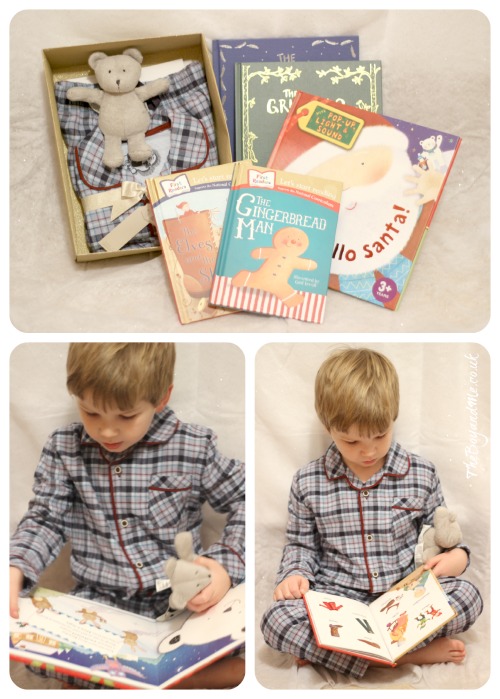
The Boy has really taken to the First Readers books which are designed to be read with an adult (one page an adult, one page a child) and thoroughly enjoys trying to read some of the words on 'our' pages. And as for the pyjamas? How cute and cosy does he look?
I was sent the pyjamas and books to help support this reading and writing project with The Boy, my thoughts and opinions are my own.
Ladybird: Read It Yourself Books (Review)
Even though he is approaching four and half years old, The Boy still adores Peppa Pig in any format. Therefore when Ladybird asked me if I'd like to review some of the books from their newly revamped 'Read It Yourself' series, and mentioned that they had titles from the pink porcine in their range, I jumped at the chance.
The Boy has been reading CVC words (consonant-vowel-consonant, e.g. cat, dog, mum) for several months now and has a developing sight vocabulary for high frequency words like 'and', 'the', 'this' or 'from'. I was sent two Level 1 books and two Level 2 books:
- Level 1: For children who are ready to take their first steps in reading;
- Level 2: For beginner readers who can read short, simple sentences with help.
The books do the right thing in that they provide an introductory page with the keywords on it, and there is also a parents' guide at the front explaining how to use the book.
So far so good.
Looking specifically at a Level 1 book here, the stories are simple and attractively presented with picture cues which can help the reader to ascertain the context of the text. Many of the high frequency words like 'this' or 'little' are repeated throughout, alongside the key vocabulary. But then into a sentence there will be a 'house' or a 'snail', or the one that really flummoxed me earlier was 'says'.
Those are not first stage readers' words.
First stage readers words are CVC words with some of the very highest frequency words, like the books we were reading together tonight which has sentences like 'Biff and Chip set off'. The Boy could work those out because the blends were easy. Segmenting and blending 'house' and 'snail' are not easy; that requires an understanding that 'ou' makes an 'ow' sound (but it can also make an 'oh' sound) and that 'ai' makes a long 'a'. Likewise knowing that 'ay' makes an 'air' sound when put into 'says'.
That's not easy. It is not for children 'who are ready to take their first steps in reading'.
In the Level 2 Peppa Pig book 'Sports Day' there are even more complicated sentences like '"Ready, steady, go!" says Madame Gazelle.' Again, this is supposed to be a book for 'beginner readers who can read short, simple sentences with help.' It's not, this is a tricky book, and although the sentence structures are repeated, the vocabulary requires working out in the first place.
I may seem overly critical here, but I think that labelling these books as Level 1 and Level 2 is not helpful to parents. I'm lucky that as a teacher I have a fairly decent understanding of phonics and how to teach reading. I would hate to see a parent buy these books for their four year old child, pressure them into trying to read it and then put them off the joy of reading.
Most schools seem to use the Oxford Reading tree reading scheme which starts off at Stage 1 or Stage 1+. They will be the books that most Reception children will start to read, and they contain sentences like, 'Dad got on it.' or 'Kipper put on a rug.'
So why the discrepancy with these 'Read It Yourself' Level 1 books?
The added complication is apparent when on closer examination of the back cover, under the bar code, there is a label 'Book banded for school use: Book Band 5 (for Level 1) or Book Band 6 (for Level 2).'
Book Banding is a system that was created to ensure that all the different reading schemes on the market could be compared realistically.
- The Oxford Reading Tree Stage 1 books which I gave examples from above are Book Band 1.
- The Ladybird 'Read It Yourself' Level 1 books are Book Band 5.
These books are beautifully presented and attractive. And I am sure that they are enticing and engaging for children to read, but the fact that they are labelled Level 1 is deceptive as it implies (and states) that they are for beginner readers and they are not; they're far more developed than that.
I was sent these products for the purpose of this post. My opinion is honest and unbiased, and based on my professional experience.
LeapFrog LeapReader (Review)
During the Summer, The Boy was fortunate enough to be sent the new LeapFrog LeapReader (for 4-8 year olds) to review. I was intrigued to see how this was any different to a few of the LeapFrog products that we have, namely the Tag Junior and the Scribble & Write, and was pleasantly surprised to see that it actually incorporates the best bits of many of the pre-existing LeapFrog learning toys.
Essentially the LeapReader does two things:
- develop reading skills
- develop writing skills
It also is marketed as developing listening skills because children can listen to audiobooks and trivia quizzes (there is a headphone jack port to prevent disturbing those around them), but for me this isn't the biggest selling point.
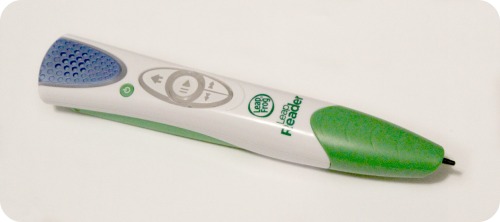
The LeapReader looks like the Tag reading pen (it also works with most Tag books), but with added extras; there is a 'nib' (in addition to the scanner for reading) which means that it can be used for 'writing' on the special paper provided with certain packs or books. It also has play/pause and next/previous track buttons, along with a 'home' button for audiobooks, and volume controls.
Developing Reading Skills – LeapReader
There are several different ways to interact with the LeapReader when reading a book, options to 'read the page' along with 'sound it, say it' and 'games' mean that each page in a book can be explored extensively. The purple book icon allows a child to hear the story read, and the green star starts up a game or quiz. This is great for first stage readers, those who want to read independently but don't have the decoding* skills or phonological awareness to 'segment and blend'* a word.
As a primary school teacher I am interested in the way that these type of learning tools use phonics to help a child 'read' independently. I'm a harsh critic of those that use the incorrect pronounciation of phonemes, it is counter-productive to their reading skills and makes a teacher's job harder. Therefore I was interested to see how the LeapReader did; was it going to be guilty of using the schwa, the 'uh' sound that so many of us learnt when reading, which is actually wrong?
I was very pleasantly surprised to hear it doing a fairly decent job actually. Common letters which can feature the 'uh' sound if mispronounced are: b, c, d, f, g, h, j, k, l, m, n, p, r, s, t, v, w. Out of those it correctly pronounced f, h, j, k, l, m, n, p, r, s, t, v, with it unfortunately using the 'uh' sound on b, c, d, g and w. I can forgive it c, d and g (they are quite tricky) but not w. Maybe that's just me being fussy, but I don't think it's helpful for such a potentially excellent learning tool to be getting some right and some wrong. However, I was very pleased to see the LeapReader explain to the user that certain letters blend together to make a different sound (e.g. e+e = e, e+a = e, i+e = i) although I'm confused as to why it uses the letter names and not the sounds to explain this (see the above video for more information).
Essentially I like that this gives the child more control over their reading, allowing them to 'read' independently once they have learnt the basics from a parent or teacher.
* Decoding is the process that readers go through when they are working out what the sounds in a word join together to make. Segmenting is splitting it into phonemes (letter sounds) and blending is joining these back up together to make a complete word.
Developing Writing Skills – LeapReader
In the review pack that we received was a 'Learn to Write Letters with Mr. Pencil' book, which also has separate practise writing paper.
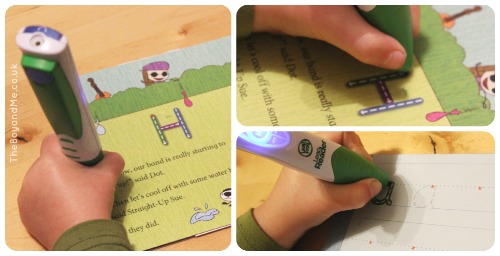
I really like the story of the Doodlebugs which guides the child through the book, and the way that they can practise on both the book and the practice paper which has been included in each section. The Boy very quickly realised though that once the paper has been 'written' on, then it's been used and there is no replacement for it. He can go over it again once or twice, but then the reader can't pick up his 'writing' correctly and it doesn't work as well. That is frustrating. The other point that he found frustrating is that the LeapReader is determined to finish the instruction he's saying and will not be interrupted. The Boy worked out very quickly what he needed to do, but wasn't able to start until the Reader had finished the instruction; it has caused a few 'grrrs' from both him and me when using it.
The LeapReader does pick up very quickly if an error has been made, and it has really helped him to find another way of practising letter formation without it feeling like I'm schooling him. As a left-hander he does find that sometimes the plastic rim around the nib gets in the way and marks the paper before the nib does, which confuses the LeapReader. It mean that he needs to check his pencil grip more frequently, so it isn't really a bad thing. The book covers upper case angular letters first (L T F E I H) rather than 's a t p i n' (initial letter sounds which children are taught to read) or 'curly caterpillars' (a c d e g o q s f – the first letter formations taught). However, it can be good for children to experience different fonts and formats, and therefore it's 'all swings and roundabouts'. If it engages children in writing and allows them to feel accomplishment then the order is pretty harmless.
The story used to teach children the letter formation is fun and engaging. The technology identifying the writing is very clever and it encourages correct pen grip.
Overall Impression
When I posted a picture of the LeapReader on Instagram, someone commented that they'd be interested to see this review as they felt it was a parent's place to teach their child to read and write, not to leave it to a piece of technology. I do see their point of view and of course the primary learning resource for any child is a parent or carer, however I know from professional experience that there comes a time when a child wants to do things independently and not be reliant on adults all the time. They want to feel that they are in control of their learning, and that they can manage without help; using an inanimate object like this (just like using a dictionary to learn a word's meaning) can be a boost for their confidence and help further consolidate what a child has learnt with an adult's help.
The LeapReader is a learning tool that can be used in a variety of ways, the appeal of this toy is that it gives a child control and independence to further their reading and writing skills. Overall I think it is a very good resource, particularly for promoting letter formation and sight recognition skills.
The LeapFrog LeapReader is available from a variety of toy retailers and online here with a RRP of £39.99 and includes a LeapReader, activity sampler book, and Learning Paper writing sheets. Supplementary books typically cost from £12.99-£16.99 (The Learn To Write Book is £16.99).
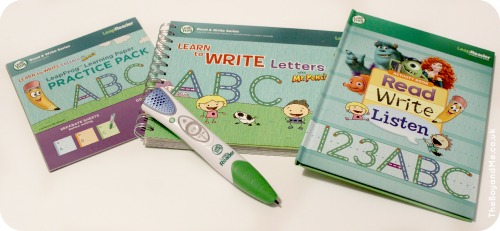
I was sent this product to review as a member of the LeapFrog Blogger Panel. My opinion is honest and unbiased, and based on my experience as a primary school teacher of twelve years, and a mother of a four year old son.
'My Jolly Phonics' Kit (Review)
For the past six months, The Boy has shown an immense interest in reading and is able to recognise 80% of the alphabet and pronounce the sound (or phoneme) correctly. He astounded us a few weeks ago by leaning over Mr. TBaM's shoulder and reading a simple CVC (consonant-vowel-consonant) word correctly, and then floored us when he continued to read the next ten words correctly by sounding them out (segmenting).
The 'My Jolly Phonics' kit we've been sent to review has come at exactly the right time!
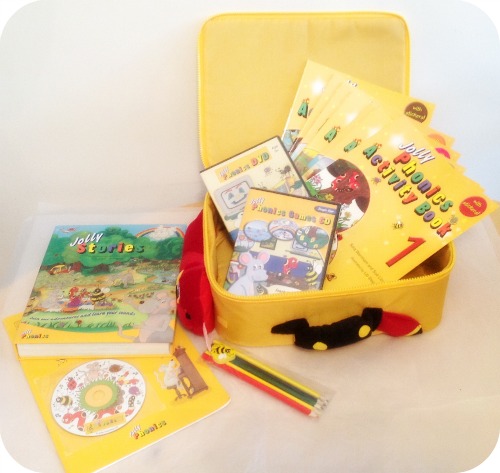
Jolly Phonics is the most widely used programme in schools for teaching children how to read. It splits the 42 phonics into progressive groups to learn, and addresses them in a fun manner.
Inside the beautiful storage bag is:
- a parents' guide;
- Jolly songs;
- activity books;
- Jolly Stories;
- Jolly Phonics games CD;
- Jolly Phonics DVD;
- a packet of coloured pencils (in an outside pocket).
The parents' guide does a brilliant job of explaining the different stages to reading using the method of 'synthetic phonics'. In this case 'synthetic' refers to 'synthesising' the letter sounds together to create words using techniques such as segmenting and blending. It's an incredibly well explained guide and one that helps to understand the process of learning to read a lot better.
Every phonic in the Jolly Phonics programme has a character and action associated with it. Jolly Songs is a brilliant resource for helping children to learn these, and because it's a CD it can be played while doing another activity and through sheer osmosis, the actions and sounds are learnt. The accompanying booklet has suggested games for parents to supplement the songs.
Inside the kit are seven activity books; one for each of the seven groups of phonics. The activity books are really good quality; full colour with a good mix of stories, discussion points, sticker activities, practical games to play, physical activities developing both gross and fine motor skills, and notes for parents. I think the activity books are one of the best resources that Jolly Phonics producs.
Jolly Stories is a hardback story book with seven stories inside; one for each group of phonics. The pages are thick, colourful and have a large focused letter on them which the child can trace with his finger to develop formational skills. The stories focus on the characters and Jolly Phonics actions in context, and are a great way of consolidating the relevant phoneme.
I had some trouble installing the Jolly Phonics Games CD and had to put it on my school laptop as it wouldn't load onto my own machine. Both are running Windows 7 so I'm not sure what went wrong (The CD can be installed on both Windows and Mac machines). During the setup it's possible to select either precursive or print letters, and suggests that in the UK we install the precursive font, which I did anyway because that's what I use in the classroom. There are three levels of play; easy, medium or hard, with plenty of activities and games within each one. I would like to point out that it's worth reading the manual because some of the games (even in the easy level) rely on understanding how to blend phonics together, and this would cause children trouble unless they've got a firm grasp on the basic phonics of that level first.
The Jolly Phonics DVD features episodes from the 1995 television series which, as they are 17 years old, aren't of a brilliant recording quality. However the content is just as relevant. It actually reminded me a little of Fingermouse from my own childhood and the characters, props and images are bright and attractive. The only thing that jarred my professional nerves slightly was the inconsistent pronounciation. The first episode focuse on 'S', 'A', 'T' (the first collection of phonics taught), yet pronounciation ranges from 'sss' to 'suh' and 't' (blunt ended) to 'tuh'. This 'uh' sound, the schwa, is avoided at all costs in phonics teaching nowadays as it gives a false phonics awareness. I think the variation in the way the phonics were said sends mixed messages to young children learning to read.
As a parent I have found this set invaluable, as a teacher it was just as helpful. I specialised in teaching junior aged children who can invariably read by the time they get to my class. I've never been taught how to help a child read, and it's only through common sense, and now my own practise with The Boy that I really appreciate the different processes involved. However, many parents who don't know where to start when supporting their child in learning to read are scared of 'getting it wrong' (rightly so) and this starter kit is a great toolkit for exactly this purpose.
Overall it's a really good resource and I would recommend it.
I was sent this product for the purpose of this review, my opinion as a parent and teacher are honest and unbiased.


